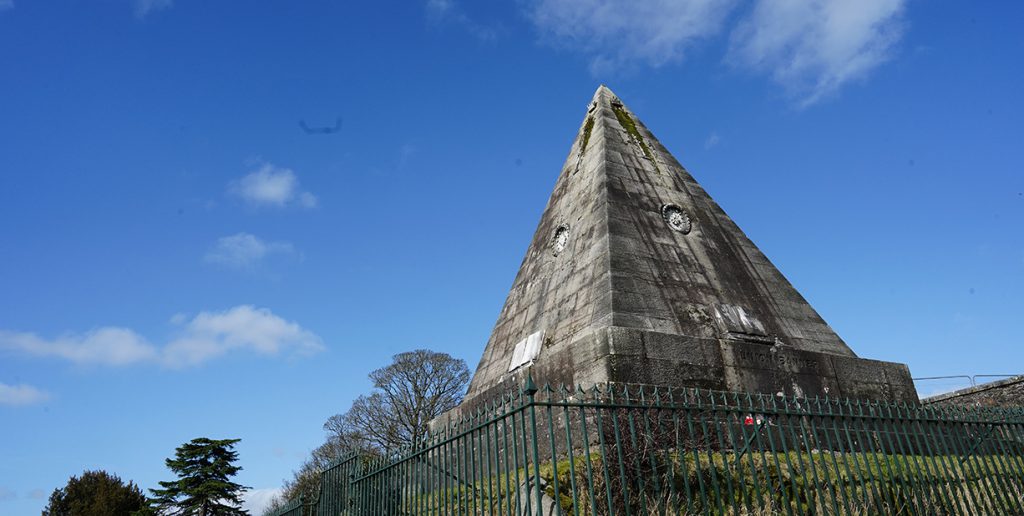The Star Pyramid
The Pyramid is dedicated to all those who suffered martyrdom in the cause of civil and religious liberty in Scotland

Separated by a driveway from the Valley Cemetery, the Drummond Pleasure Ground was laid out as a setting for the Star Pyramid which is a massive sandstone ashlar pyramid which dominates this area, standing on a stone stepped base upon a shaped grassy mound. Marble Bibles rest on the base of each face of the pyramid, which is also carved with references to Biblical texts.
The pyramid is enclosed by wrought iron railings, with stone steps to S flanked by 2 stone globes (once surmounted by bronze eagles). A Bible and Confession of Faith were sealed into an inner chamber in the pyramid. The Pithy Mary pond lies to the W of the Star Pyramid with bridge of wrought / cast iron work including later repair work and a grassed slope beyond to the W with lawn and deliberately placed rocks. There are no gravestones within Drummond Pleasure Ground other than William Drummond’s sarcophagus to the NW of the pyramid; polished grey granite inscribed ‘Born 14 February 1793 Died 25th November 1888′ on its stepped base.
Outside the church is the Valley Cemetery. In past times was the site of jousting tournaments and markets. The Cemetery has a Pyramid, built by William Drummond in 1863.
William Drummond was a land surveyor and nurseryman whose immediate descendants were a well known family in Stirling. They were responsible for a wide range of activities both locally and nationally. These included the establishment of an agricultural museum in the 1830’s, an extensive seed and nursery business, exploration in Africa and the Drummond Tract Enterprise, the foremost 19th century publisher of religious pamphlets.
William was the eldest son of the well-known Stirling family which included Peter Drummond and his nephew Henry. He was one of the instigators of the Valley Cemetery and his obsession with religion can be seen in the Martyrs’ Monument and the Star Pyramid (also known as Salem Rock).
He commissioned the Star Pyramid from William Barclay in 1863 – note the white marble Bibles incorporated by Barclay round the base of the edifice and the names of religious tracts (published by his brother Peter’s “Drummond Tract Enterprise”). The Pyramid is dedicated to all those who suffered martyrdom in the cause of civil and religious liberty in Scotland.William planted a Pleasure Garden round the Pyramid, complete with trees and plants. He also paid for five of the six statues seen in various parts of the graveyard and donated trees to be planted round the National Wallace Monument.
This area was laid out as a public pleasure ground by local nurseryman and evangelist, William Drummond. The Star Pyramid, with its texts and emblems, was nearing completion in April 1863, when a bible and the Confession of faith were sealed into a chamber within the structure. It recalls the principles of the Reformation and publicised the famous Drummond Tract Enterprises.
The pyramid is on a raised plinth of 4 steps and has a set of steps leading to it. Each of the faces are very similar. On one face is a circular marble plaque, the text of which is very worn and some of the lower part is readable.
Each of the sides has (from bottom to top):
- sunken relief text with a reference to verses from the Psalms:
- Union Banner, XLV CIII
- Rock of Ages, XCV
- Covenant Rest, CXXXII CXLV
- Thrown of Right, XCVI XCVII
- marble bible
- carved circular rosette
- thistle
- crown

